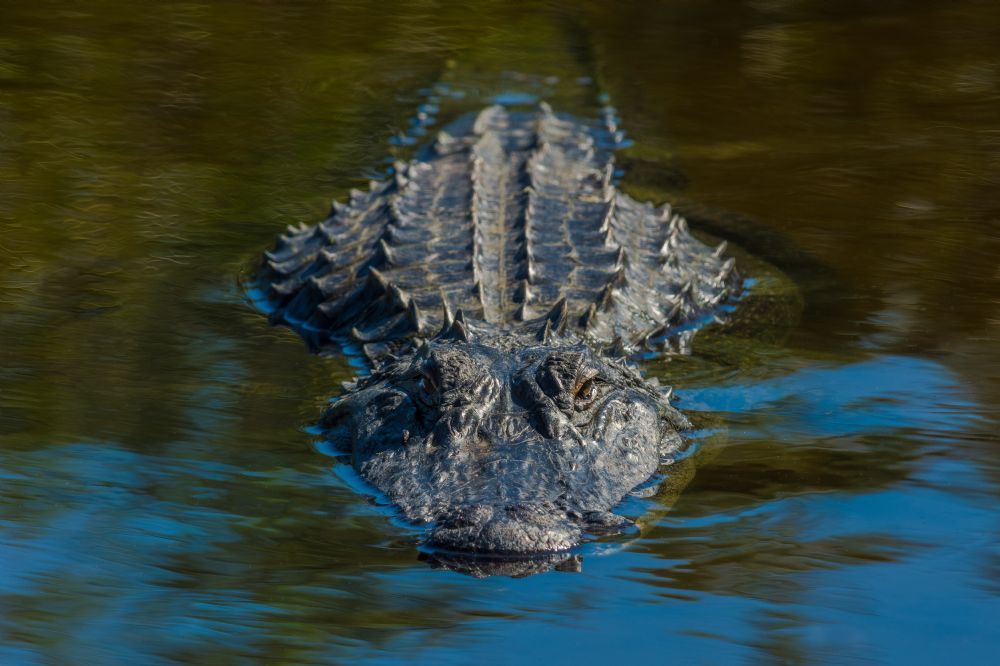Alabama Department of Conservation and Natural Resources
For those of us fortunate enough to have lived in Alabama a number of years, one of the benefits the vast majority of residents cherish is interaction with the abundant wildlife that inhabits the state.
Becoming familiar with the different animal species and their preferred habitat comes with experience and education. Most of those animals are harmless, but a few species need to be given distance and avoided. A case in point is the American alligator, which can grow up to 15 feet in length.
An American alligator was recently sighted in the Huntsville area, which many people consider to be beyond the home range of the animal. However, alligators have lived in north Alabama for at least 60 years, according to Chuck Sykes, Director of the Alabama Department of Conservation and Natural Resources’ (ADCNR) Wildlife and Freshwater Fisheries (WFF) Division.
“The first documented sighting was at Wheeler National Wildlife Refuge (near Decatur) in 1964,” Sykes said. “They’ve been in north Alabama for a long time.
“I get it. People who are new moving into the area who are not used to it, I can see where they could be a little panicked the first time they see an alligator. But that is suitable habitat for alligators. There is not as much prime gator habitat as there is in the southern part of the state, but there is still quite a bit up north.”
Jud Easterwood, WFF’s Supervising Wildlife Biologist in District I in north Alabama, said some evidence exists that alligators were living in his district much longer than that.
“We’ve got alligators in Wheeler Refuge and Redstone Arsenal and the areas surrounding,” Easterwood said. “We have historical accounts from the late 1800s of them being there.”
In the middle of the 20th century, alligators were listed as endangered by the U.S. Fish and Wildlife Service (USFWS) and protected for 20 years until they were delisted in 1987.
“We know the population is there,” Easterwood continued. “We see them at Swan Creek (wildlife management area) occasionally and at Brown’s Ferry Nuclear Plant.”
Recently, the housing boom in the Huntsville-Decatur-Madison triplex has encroached into areas that are suitable alligator habitat.
“They are building subdivisions literally in swamps,” Easterwood said. “They’re bringing in truckloads of dirt and topsoil to build these pads to put the houses on. They’re building right up against the Redstone Arsenal fence. They’re building these well-manicured ponds these houses are going to go around. That means fish and turtles, food sources of alligators, so everything is there for an alligator. It’s perfect for them.
With the encroachment of subdivisions and other construction near the alligators’ habitat, interactions between humans and alligators will arise. Folks moving into the area who aren’t familiar with Alabama’s native wildlife are sounding off.
“We have people moving in from all over the country coming to the Huntsville area, and they are not made aware that there is a breeding population of alligators here. When people see them, they freak out. They don’t know what people in south Alabama know about living around alligators.”
Easterwood said those people unfamiliar with alligators want the animals they see gone immediately, but WFF has a regulated protocol to determine if the animal is considered a nuisance alligator and merits removal.
“Is it approaching people?” he said. “Or is it just lying up on a bank? We have a protocol because the alligator is still a federally protected species. We don’t get a phone call and then go out and kill it. Because the alligator is a federally protected species, the protocol we use to determine if the animal is considered a nuisance is written in our state regulations. We do assess each reported nuisance situation, which is initially done over the phone. This initial phone interview allows for us to better understand the situational complaint and determine what the next steps should be.
“If and when warranted, we use a nuisance alligator specialist that we’ve worked with for a couple of decades. We know him and trust him. If we call him, he drops what he’s doing and takes care of the alligator. But we rarely have to take an alligator.”
Easterwood said he and the WFF staff try to educate callers about how to live with alligators in Alabama (www.outdooralabama.com/livingwithalligators).
“We give them the dos and don’ts of alligators,” he said. “Leave the alligators alone. Don’t harass them. Never feed alligators. Don’t throw fish scraps in the water. Don’t let your pets swim in those areas. Keep pets on a leash. If you know alligators are in the area, you probably don’t want to swim there either.
“I’ve been telling people that if you have a wetland or pond big enough for an alligator, you’d better assume there is one just to be safe and approach that pond or wetland with that in mind. That’s what people in south Alabama, Florida and the low country of South Carolina do.”
The alligator education outreach is ongoing with assistance from the City of Huntsville, which is erecting caution signs in areas that are suitable alligator habitat. Huntsville already has a leash law for dogs.
Easterwood said alligators don’t make a distinction among prey animals. If they can capture it, it will be consumed.
“Alligators eat beavers, muskrats, deer, if they can catch it, or a coyote,” he said. “A dog coming through a shallow water swamp is no different from any of those animals. They are just natural prey to an alligator, not unnatural at all.
“It’s about getting people to understand alligators are here; they’re not going to go away. This is important, and I’ve stressed this to a lot of people I’ve talked to: You can call us and say there’s an 8-foot alligator in your pond. If we determine it is a nuisance and remove the alligator, there’s no guarantee that the next night a 10-foot alligator isn’t going to show up in that pond. The removal of an alligator should not change that line of thinking that if there is a wetland or pond, there could be a gator in it. That line of thinking is hard to get people to understand. It’s about education, and sometimes it’s hard to reach people, and sometimes it’s a hard message for people to receive. It’s like trying to get people to leave a baby fawn alone. How many people haven’t gotten that message? It’s a constant struggle.”
Sykes added, “Removing every alligator you see is not a feasible solution.”
Easterwood said some callers have suggested an alligator season in north Alabama similar to the seasons in south Alabama. Sykes said expanding the alligator season is not possible at this time.
“Just because people are seeing a few alligators in north Alabama, that doesn’t mean there are enough to sustain a huntable population,” Sykes said.
Sykes said with proper precautions, Alabama residents can relish the opportunity to observe nature and wildlife.
“Alabama is home to a myriad of wildlife species that can become nuisances, mainly if people allow them to be,” he said. “If you’re feeding raccoons cat food on your back porch, that can turn into a nuisance. If your garbage is out when bears are on the move, same thing. We have alligators at our place in Choctaw County. I do not allow my dog to swim in the slough when it’s warm outside. It’s just common sense.
“There are simple precautions you can take that make living with wildlife cool and enjoyable.”


 Login
Login




